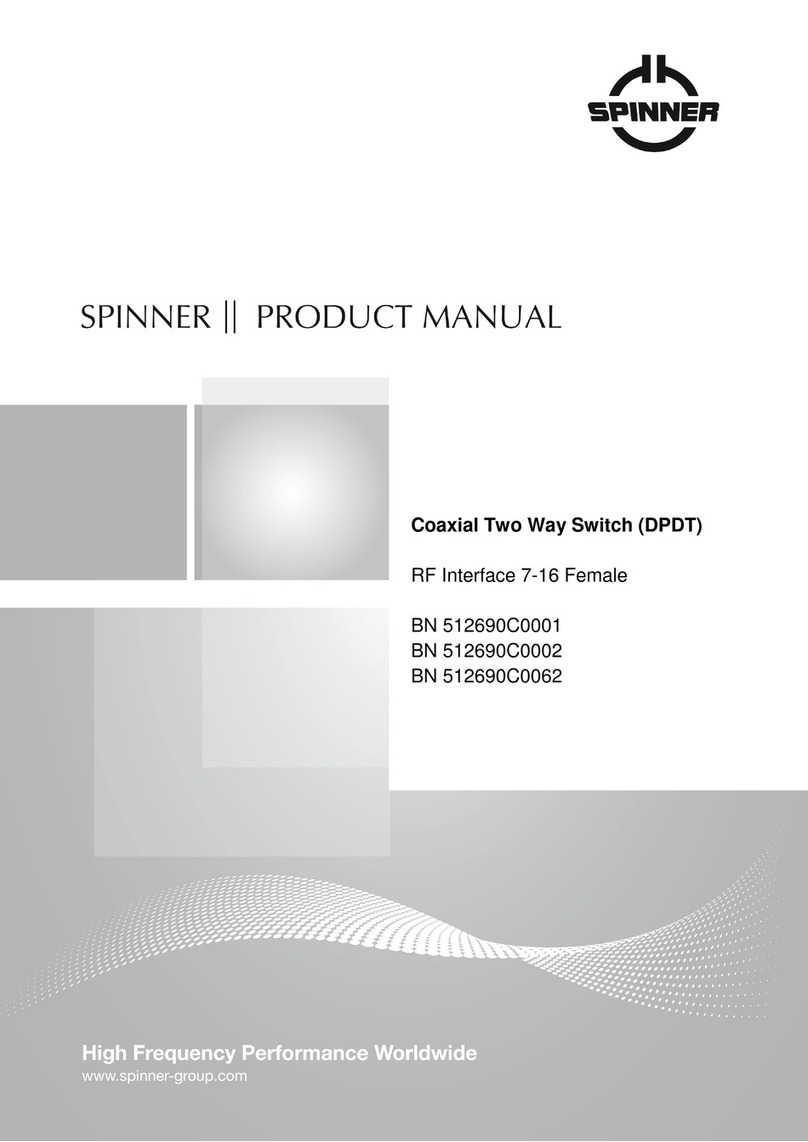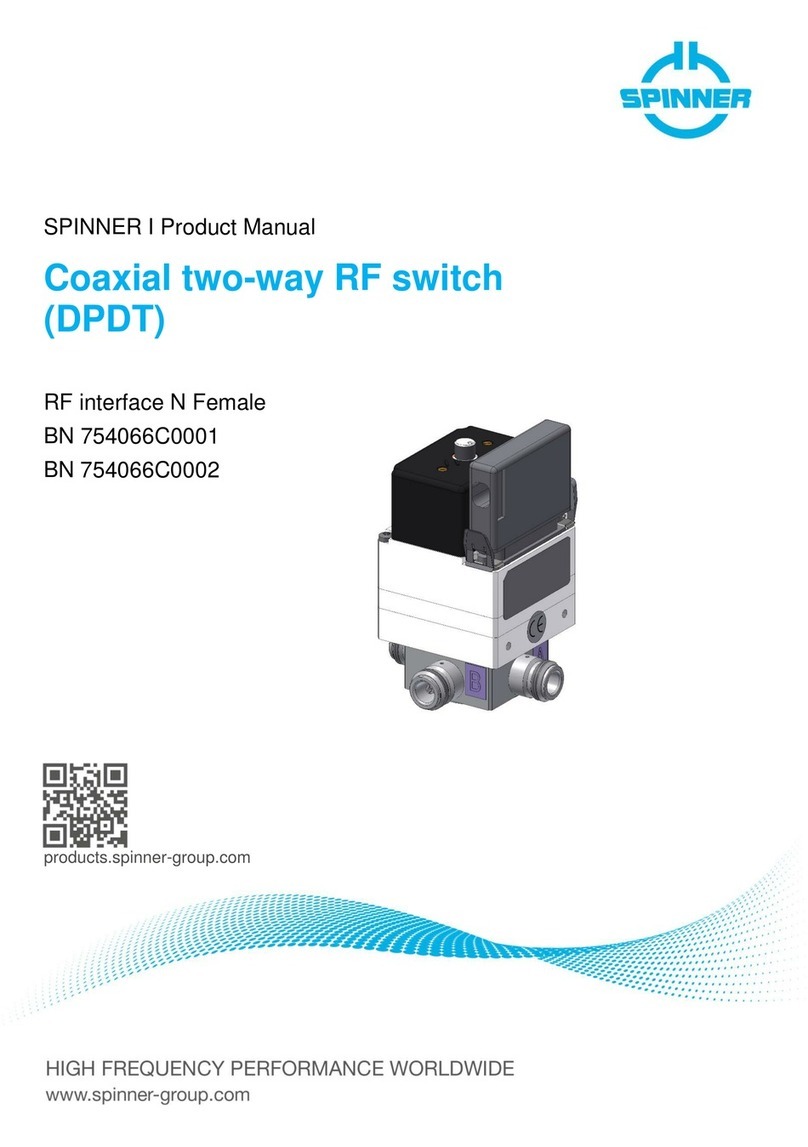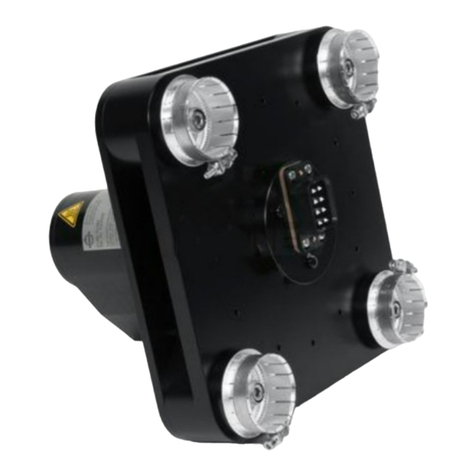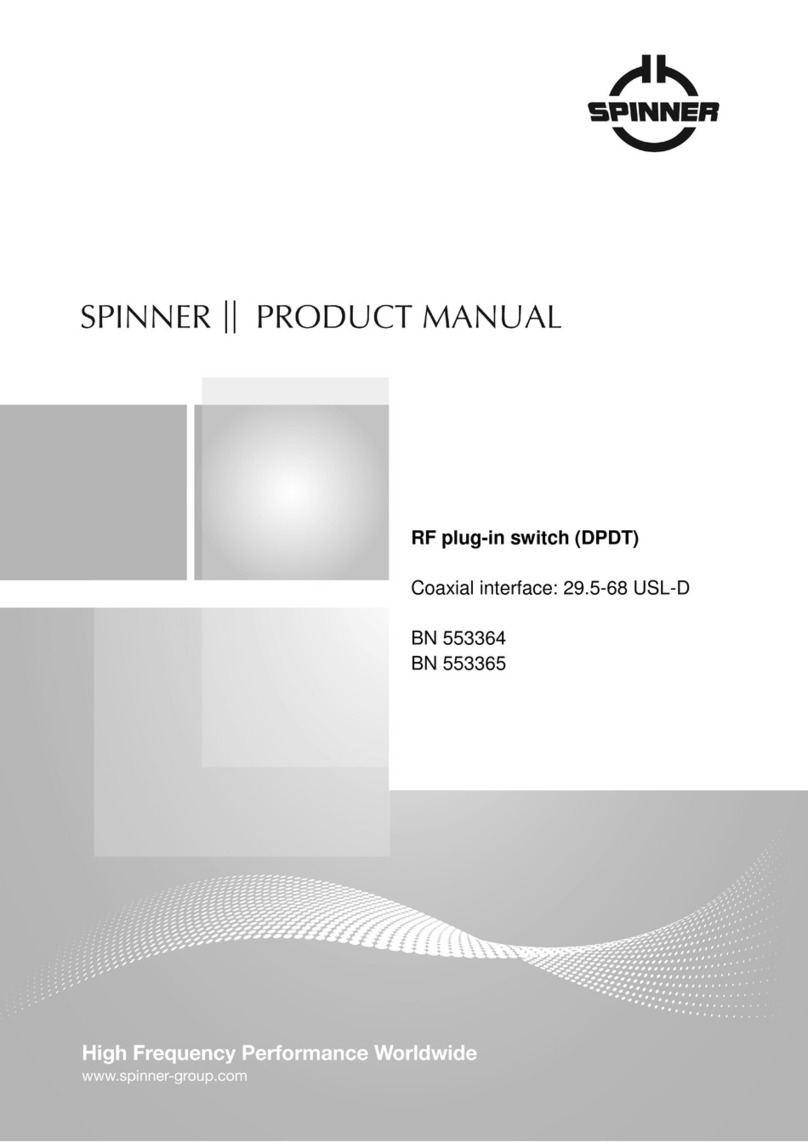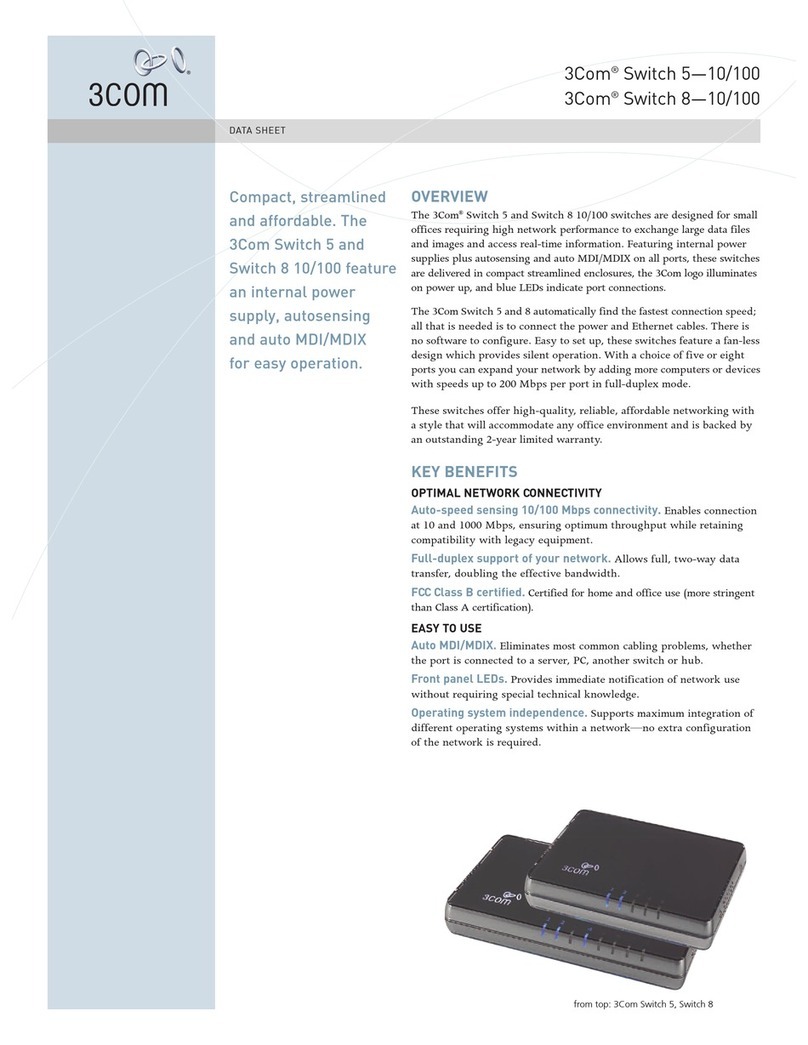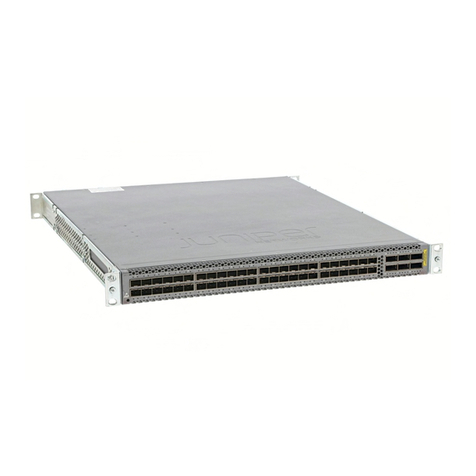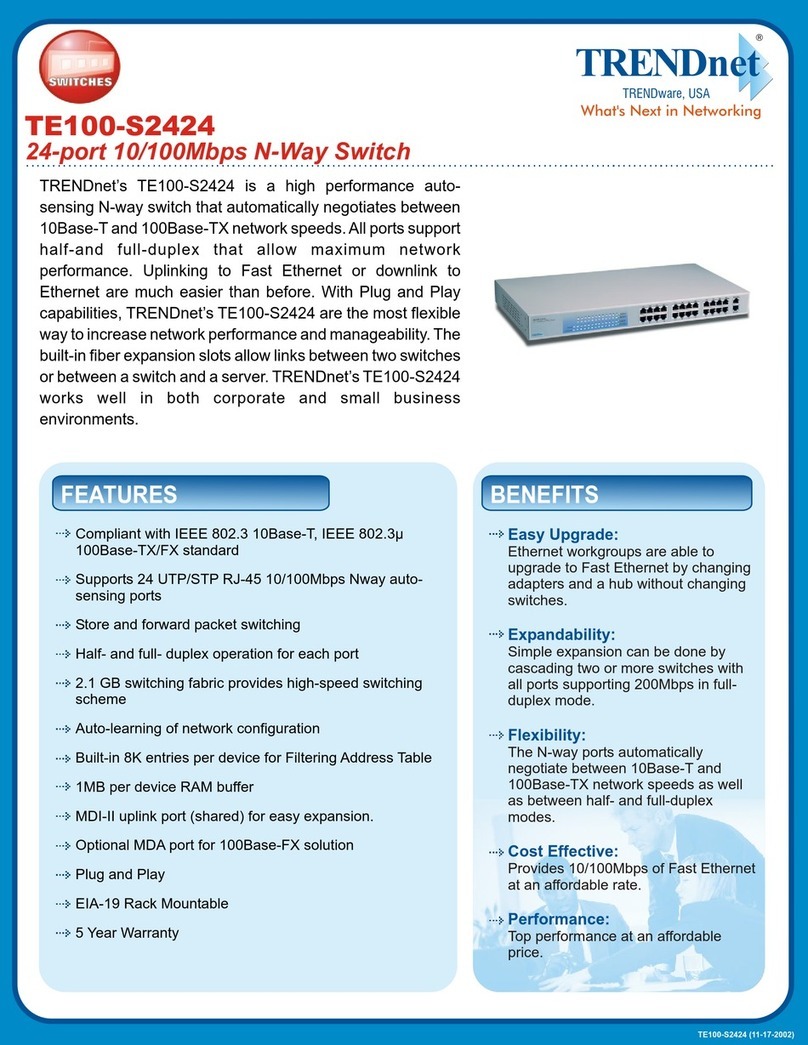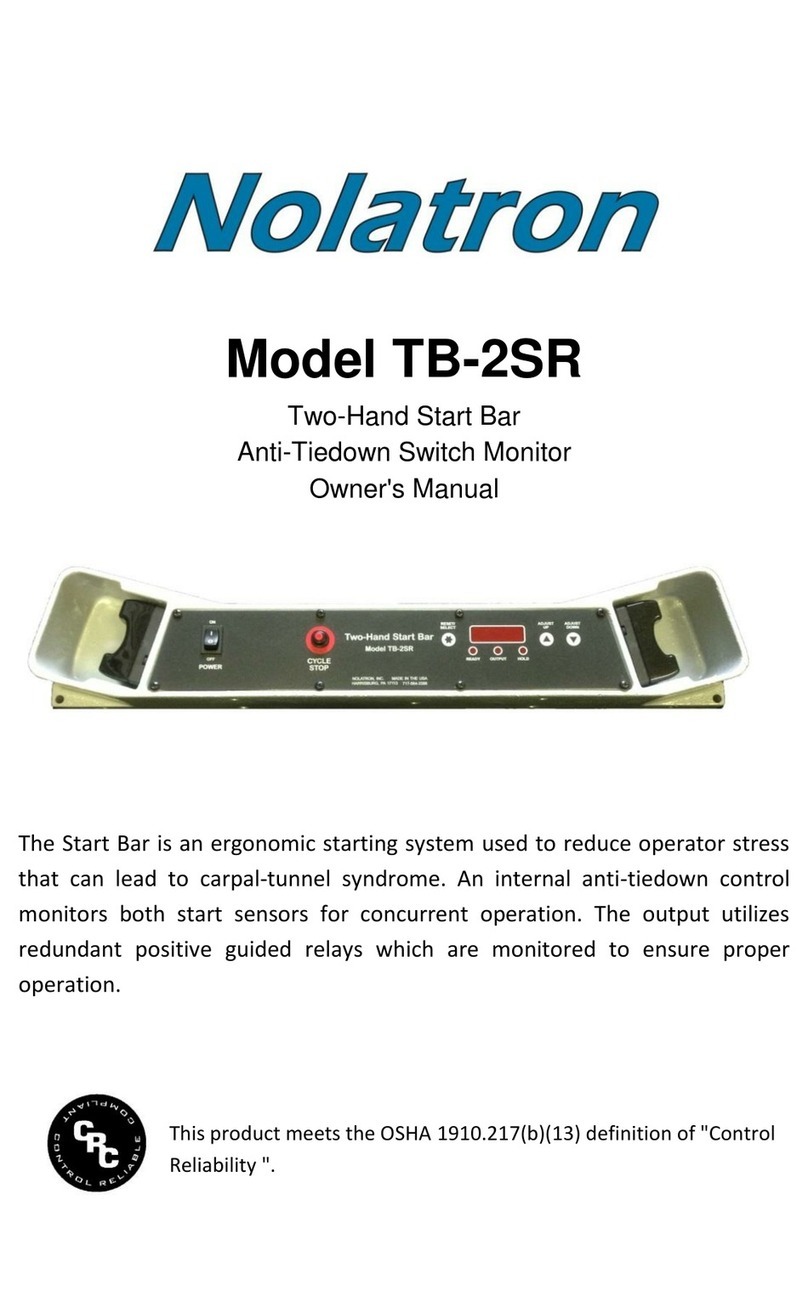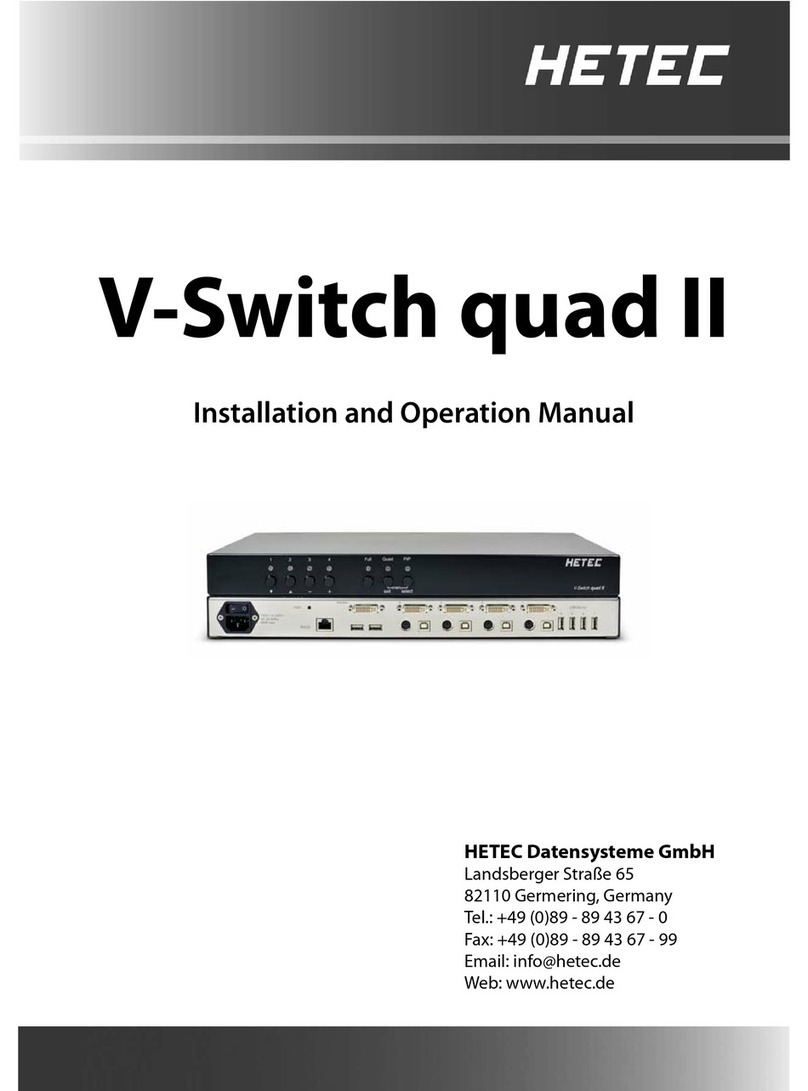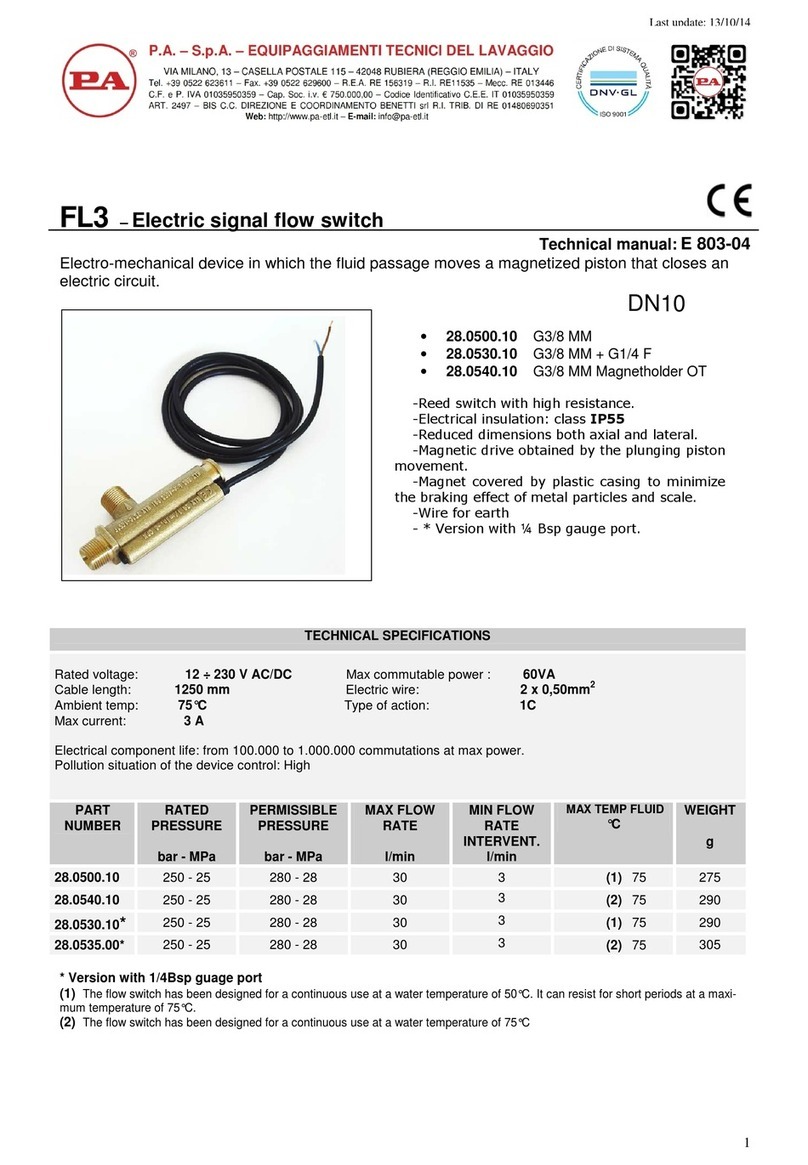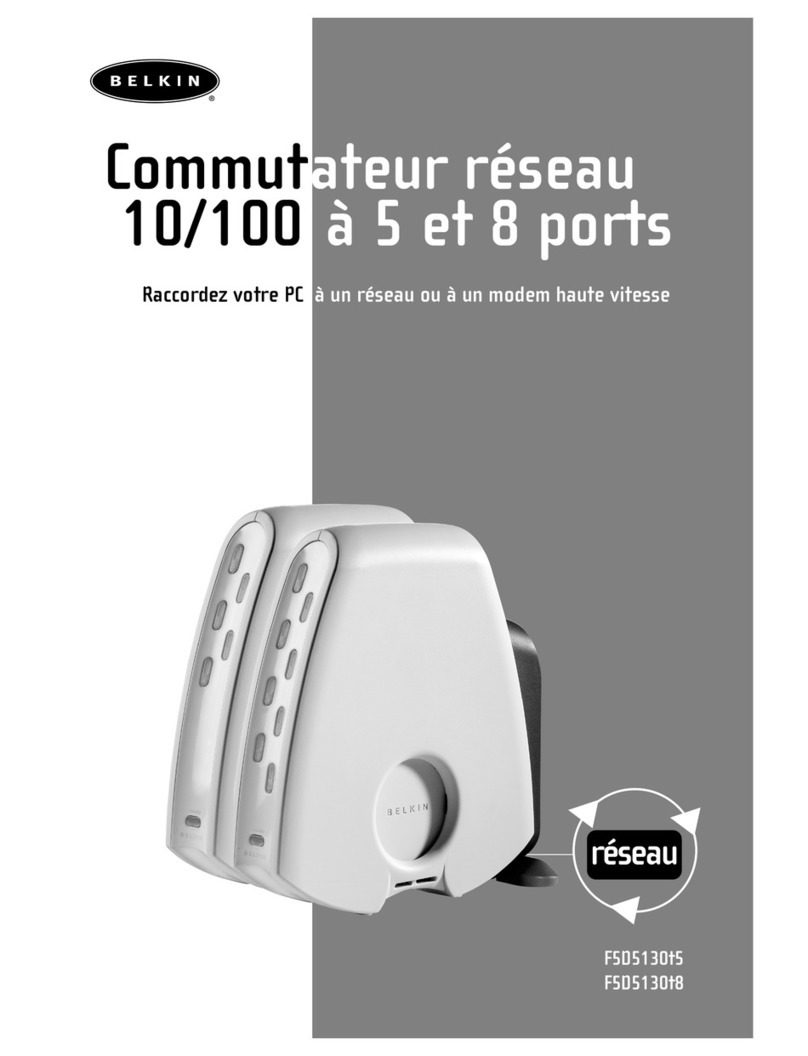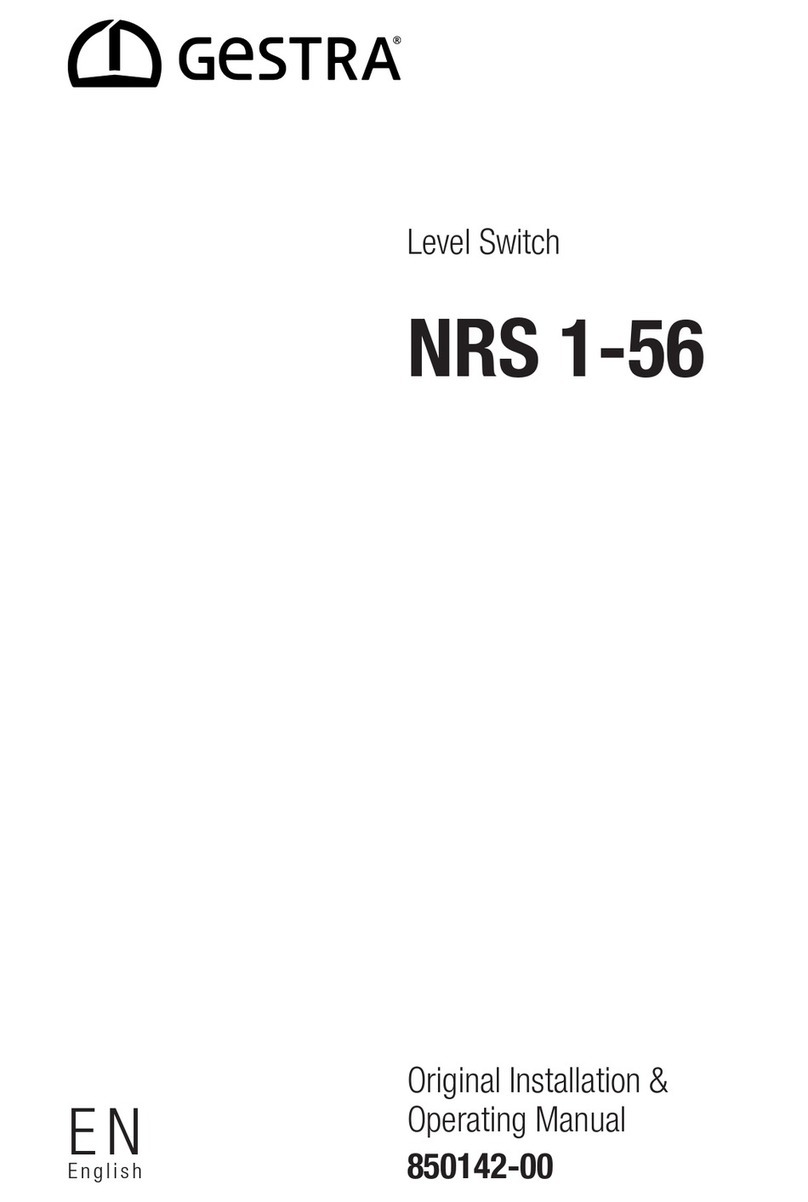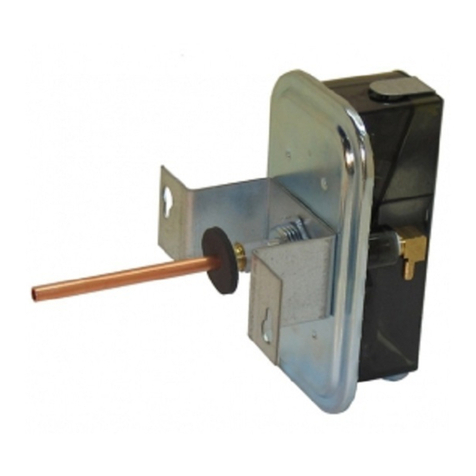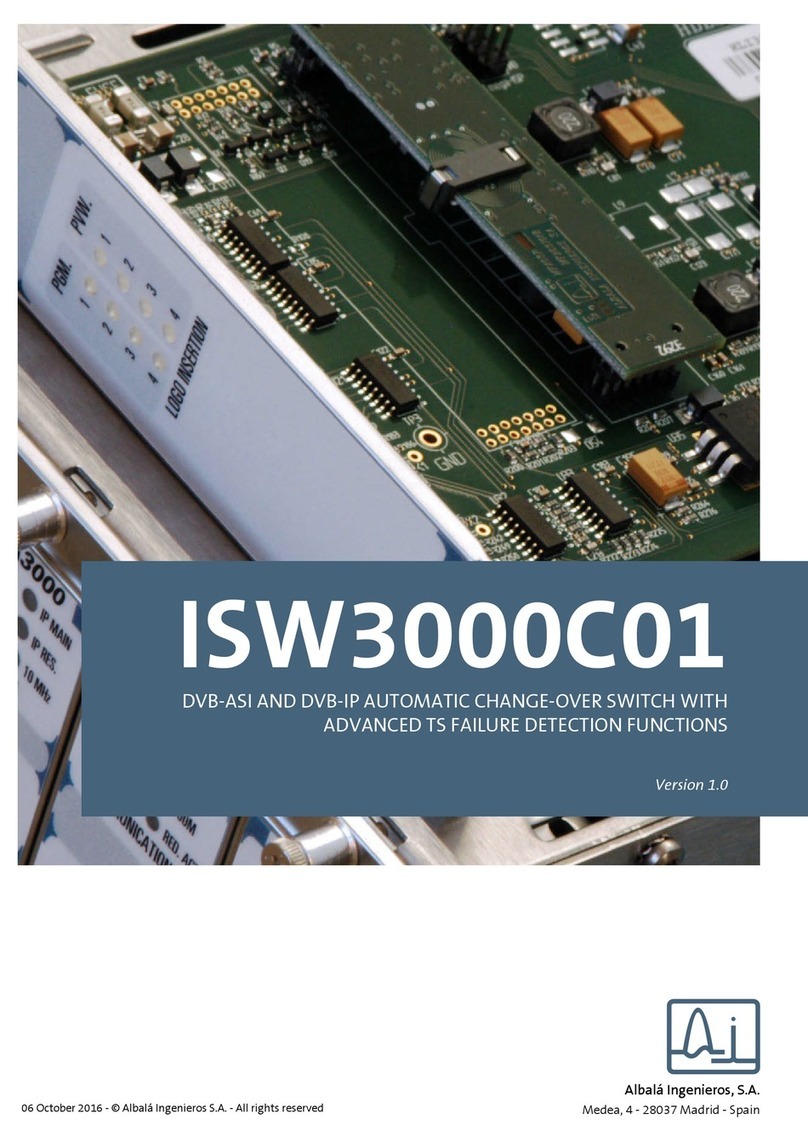Spinner BN 553664 User manual

RF plug-in switch (DPDT)
Coaxial interface: 43-98 USL-D
BN 553664
BN 553665

Data subject to change without notice │M36275 │Issue B
www.spinner-group.com
2 / 23
Content
1.Basic Safety Instructions for SPINNER Broadcast Products...................................................................3
2.Intended use.............................................................................................................................................6
3.Improper use ............................................................................................................................................6
4.Function....................................................................................................................................................6
4.1Motor drive ...............................................................................................................................................6
4.2SPINNER crank drive...............................................................................................................................6
4.3Bistable switching property (latching).......................................................................................................7
4.4Manual override........................................................................................................................................7
4.5Visual position indicator ...........................................................................................................................7
4.6Interlock / signal contacts.........................................................................................................................7
4.7Earthing terminal ......................................................................................................................................7
4.8Strapping plug for USL-interlock I ............................................................................................................7
5.Data sheet ................................................................................................................................................8
6.Dimensions (all dimensions in millimeters) ............................................................................................11
7.Circuit diagrams .....................................................................................................................................12
8.Storage...................................................................................................................................................14
9.Transportation ........................................................................................................................................14
10.Installation ..............................................................................................................................................15
10.1Mechanical and RF installation ..............................................................................................................16
10.2Electrical installation...............................................................................................................................17
11.Commissioning.......................................................................................................................................19
12.Operation................................................................................................................................................19
13.Cleaning .................................................................................................................................................20
14.Maintenance...........................................................................................................................................20
15.Repairs ...................................................................................................................................................20
16.Warranty.................................................................................................................................................20
17.Demounting ............................................................................................................................................21
18.Disposal..................................................................................................................................................22
19.Additional endangering (regardless to life cycle) ...................................................................................22
20.Environmental friendly usage period......................................................................................................22
21.Spare parts.............................................................................................................................................23
22.Accessories (not in delivery) ..................................................................................................................23
23.Contacts .................................................................................................................................................23

Data subject to change without notice │M36275 │Issue B
www.spinner-group.com
3 / 23
1. Basic Safety Instructions for SPINNER Broadcast Products
The following instructions and safety instructions are to be carefully read and followed!
The Spinner group makes every effort to keep the safety standard of our products up to date to be able to offer our
customers the highest possible degree of safety. Our products are designed and tested in accordance with the relevant
safety standards. Compliance with these standards is continuously monitored by our quality assurance system. The
product described here has been designed and tested in accordance with the respective EU guidelines and has left the
manufacturer’s plant in a condition fully complying with safety standards. To maintain this condition and to ensure safe
operation, observe all instructions and warnings provided. If you have any questions regarding these safety instructions,
the Spinner group will be happy to answer them.
The operator is responsible for using the product in an appropriate manner. This product must not be used in any way that
may cause personal injury or property damage. The operator is responsible if the product is used for an intention other
than its designated purpose or in disregard of the manufacturer's instructions. The manufacturer shall assume no
responsibility for such use of the product.
The product is used for its designated purpose if it is used according to the specifications listed in the product’s
documentation within its performance limits (see data sheet, performance specifications, circuit diagram, the following
safety instructions).
Putting the product into operation requires special technical skills and must be executed by qualified personnel with
reference to “Start-up information” in the product documentation. Keep the basic safety instructions and the product
documentation in a safe place and pass them on to the subsequent users.
Symbols and safety markings
General hazard Warning!
Risk of
electric shock
Warning!
Hot surface
PE terminal Earthing
terminal
Warning!
High weight
Warning!
Non-ionised
electromagnetic
radiation
Pacemaker
hazard area
Use foot guard Use eye
protection
Use safety
gloves
Observe product
documentation
Observing the safety instructions will help prevent personal injury or damage of any kind caused by dangerous situations.
Therefore, carefully read through and adhere to the following safety instructions before putting the product into operation. It is also
absolutely essential to observe the additional safety instructions on personal safety that appear in relevant parts of the
product documentation.
Tags and their meaning
DANGER Indicates a hazardous situation conveying great risk which, if not avoided, will result in death or serious
injury.
WARNING Indicates a hazardous situation conveying moderate risk which, if not avoided, could result in death or
serious injury.
CAUTION Indicates a hazardous situation conveying minor risk which, if not avoided, may result in minor or moderate
injury.
ATTENTION Indicates the possibility of faulty operation that can damage the product.
These tags are in accordance with the standard definition for civil applications in the European Economic Area. Definitions
that deviate from the standard definition may also exist in other economic areas or military applications. It is therefore
essential to make sure that the tags described here are always used only in connection with the related product
documentation and the related product. The use of tags in connection with unrelated products or documentation can result
in misinterpretation and thus contribute to personal injury or material damage.

Data subject to change without notice │M36275 │Issue B
www.spinner-group.com
4 / 23
1. These products must be operated only under the operating conditions specified in the product documentation. All
instructions for start-up, operation and servicing listed in the product documentation have to be observed.
2. Applicable local or national safety regulations and rules for the prevention of accidents must be observed in all
work performed. Only authorized and specially trained personnel shall work with these products.
3. Operating the products requires special training and intense concentration. Make sure that persons who use the
products are physically, mentally and emotionally fit enough to do so; otherwise, injuries or material damage may
occur. It is the responsibility of the employer/operator to select suitable personnel for operating the products.
4. The product must be installed and operated in operating sites with limited access only. Access for authorized
qualified personnel must be regulated by the operator.
5. Unless otherwise specified, these products are not protected against penetration of liquids, gases, steam, etc. If
this is not taken into account, there exists the danger of electric shock for the user or damage to the product, which
can also lead to personal injury.
6. Never use the product under conditions in which condensation has formed or can form in or on the product, unless
otherwise specified.
7. These products are not explosion protected. They must not be operated in explosion-prone areas.
8. Do not place the product on heat-generating devices such as radiators or fan heaters. The ambient temperature
must not exceed the maximum temperature specified in the product documentation. Product overheating can
cause electric shock, fire and/or serious personal injury or death.
9. Do not place the product on surfaces, vehicles, cabinets or tables that for reasons of weight or stability are
unsuitable for this purpose. Always follow the manufacturer's installation instructions when installing the product
and fastening it to objects or structures (e.g. walls and shelves). An installation that is not carried out as described
in the product documentation could result in personal injury or death.
10. The product may be very heavy. Therefore, the product must be handled with care. In some cases, the user may
require suitable lifting gear to avoid back or other physical injuries.
11. The user is responsible for safe transport, parking and storage of the product. When using auxiliary objects (e.g.
lifting gear, trolleys, shelves), the user has the duty to review their suitability prior to use. Transport and storage of
the product are permitted only in the manufacturer's original packaging.
12. Handles on the product are handling aids and intended solely for people. Therefore, it is not permitted to use the
handles for mounting on or at means of transportation, e.g. cranes, carts etc. Lifting lugs serve for transportation
or lifting with crane.
13. Mains driven products must be operated only from a power distribution system. The operator is responsible for
using an appropriate and sufficiently dimensioned AC power line. The AC power line must be externally fused
according to the product documentation.
14. Operation of products of safety class I is only permitted with sufficient "Protective Earth" connection. Connection
to "Protective Earth" must be done in the way provided and described in the product documentation. The operator
is responsible for inspecting PE continuity by a qualified professional.
15. All connectors on cables from and to the product must be connected firmly. The connectors shall not be dusty or
dirty. Otherwise, danger of fire and/or injuries can occur. Intentionally breaking the protective earth connection
either in the AC power line or in the product itself is not permitted. Doing so can result in the danger of an electric
shock from the product. If extension cables are used, they must be sufficiently dimensioned and checked on a
regular basis to ensure that they are safe to use.
16. Do not overload any sockets, extension cords or connector strips; doing so can cause fire or electric shocks.
17. Operation of the product with a damaged cable is not permitted. All cables must be checked on a regular basis to
ensure that they are in proper operating condition. By taking appropriate safety measures and carefully laying the
power cable, ensure that the cable cannot be damaged and that no one can be hurt by e.g. tripping over the cable
or suffering an electric shock.
18. If the product is equipped with an earthing terminal connection (equipotential connection), the earthing terminal
must be connected sufficiently dimensioned to earth.
19. If a product is to be permanently installed, the connection between the PE terminal on site and the product's PE
conductor must be made first before any other connection is made. The product may be installed and connected
only by a licensed electrician.
20. For permanently installed equipment without built-in fuses, circuit breakers or similar protective devices, the supply
circuit must be fused in such a way that anyone who has access to the product, as well as the product itself, is
adequately protected from injury or damage.
21. Use suitable overvoltage protection to ensure that no overvoltage (such as that caused by a bolt of lightning) can
reach the product. Otherwise, the person operating the product will be exposed to the danger of an electric shock.
22. Any object that is not designed to be placed in the openings of the housing must not be used for this purpose.
Doing so can cause short circuits inside the product and/or electric shocks, fire or injuries.
23. Dangerous voltage must not reach the product over the outer conductor / waveguide.

Data subject to change without notice │M36275 │Issue B
www.spinner-group.com
5 / 23
24. All externally connected circuits for control, alarm and signalling must be supplied by SELV power sources (SELV
according to DIN EN 60950-1). The current in these circuits must be limited to the values specified in the product
documentation by means on an external fuse.
25. Before applying RF power to the product, it must be ensured that all connecting elements are professionally
connected and all unused ports are terminated. RF connections must have sufficient mechanical strength. If the
product features an interlock system, it must be connected and tested for function in advance.
26. Unless expressly permitted, never remove the cover or any part of the housing while the product is in operation.
Doing so will expose circuits and components and can lead to injuries, fire or damage to the product.
27. Repairs must be carried out by the manufacturer or technical personnel authorized by the manufacturer only.
28. As with all industrially manufactured goods, the use of substances that induce an allergic reaction (allergens) such
as nickel cannot be generally excluded. If you develop an allergic reaction (such as a skin rash, frequent sneezing,
red eyes or respiratory difficulties) when using a SPINNER product, consult a physician immediately to determine
the cause and to prevent health problems or stress.
29. Broadcasting systems or improper use of this product may produce an elevated level of electromagnetic radiation.
Considering that unborn babies require increased protection, pregnant women must be protected by appropriate
measures. Persons with pacemakers may also be exposed to risks from electromagnetic radiation. The
employer/operator must evaluate workplaces where there is a special risk of exposure to radiation and, if
necessary, take measures to avert the potential danger.
30. In the event of a fire, the product may release hazardous substances (gases, fluids, etc.) that can cause health
problems. Suitable measures must be taken, e.g. wearing of protective masks and protective clothing.
31. Products in operation may be hot. Touching them might cause burns.
32. If the product is pressurized, applicable local or national safety regulations for pressure equipment must be
observed.
33. Blocking of constructive openings on the product (ventilation slots, fine leaks etc.) must be prevented to ensure
safe operation.
34. Before cleaning, disconnect the product and all transmitters connected to the product from mains. Use a soft, but
not damp lint-free duster for cleaning. Do not use any chemical cleaning agents.
35. If handling the product releases hazardous substances or fuels that must be disposed of in a special way, e.g.
coolants that must be replenished regularly, the safety instructions of the manufacturer of the hazardous
substances and the applicable regional waste disposal regulations must be observed. Also observe the relevant
safety instructions in the product documentation. The improper disposal of hazardous substances can cause health
problems and lead to environmental damage.
36. The operator is responsible for disposing of the product according to national waste disposal regulations. Improper
disassembly or disposal may be hazardous.
37. SPINNER RF switches are not equipped with separating equipment for safe disconnection from mains. The user
must provide external separation equipment. The mains connector must be de-energized during plugging.
38. Do not actuate RF position Iand RF position II of RF switches simultaneously to avoid RF switch damage.
39. Do not touch or block the emergency manual override during electrical switch over to avoid injuries and switch
damage.
40. Disconnect RF switches from mains before using the emergency manual override of the drive unit to avoid injuries
and switch damage. The emergency manual override serves solely for switching the RF switch manually in a dead
state.
41. Switch over RF switches only without applying RF power to avoid injuries and damage. Hot switching with RF on
is not permitted. Ensure all switches are in the respective end position before applying RF power.
42. Switch off RF power before disconnecting RF connectors to avoid burns, eye injuries and electric shock. Utilize
appropriate devices and methods to prevent accidental energizing.

Data subject to change without notice │M36275 │Issue B
www.spinner-group.com
6 / 23
2. Intended use
The intended use of the product is switching over (Double Pole Double Through or Single Pole Double
Through) between two coaxial paths of an RF system in indoor applications on operating sites with
limited access. Details and other limits are given in the data sheet of this manual.
The product may only be operated within the specifications given in the data
sheet of this manual. Failure to observe could result in death or serious injury.
3. Improper use
The product is not intended for any other purpose than indicated above.
Do not use
in explosion-prone atmosphere
on operating sites with unlimited access
in outdoor applications
to support mechanical loads
with modifications not authorized by SPINNER
in damaged condition
without correctly connected interlock system
in conditions and environments beyond the specifications given in the data sheet of this manual
If the RF plug-in switch is not used as intended, safe operation of this product cannot be guaranteed.
The user is responsible for all personal injury and property damage resulting from improper use.
Reading the manual as well as adhering to all the information provided – particularly the safety
instructions - is considered mandatory to comply with the intended use.
4. Function
4.1 Motor drive
A capacitor motor with a supply voltage of 230 V AC 50/60 Hz is used to actuate the RF plug-in switch
via a special crank gear box developed by SPINNER. Depending on the type of switch the drive control
system enables remote switching by means of a control voltage of 230 V AC, 50/60 Hz or 8 to 31 V
DC.
Order number Control voltage
BN 553664 8 V DC to 31 V DC
BN 553665 230 V AC
4.2 SPINNER crank drive
To avoid contact bounce at fast switching time, the switch is equipped with a crank gear box. It
effectuates a change of torque and angular speed during the switching process. At the beginning of
the switching process, the crank gear box offers very high torque at low angular speed. With increasing
rotation angle of the switch, the angular speed increases continuously, while the torque decreases.
The behaviour reverses after passing the centre position of the switch, i.e. the angular speed
decreases while the usable torque increases. The drive unit is mechanically interlocked at the end
positions.

Data subject to change without notice │M36275 │Issue B
www.spinner-group.com
7 / 23
4.3 Bistable switching property (latching)
The RF plug-in switches show a bistable switching behaviour. Switching takes place from one stable
state into another after applying the control voltage. For this reason, an impulse control signal is
sufficient. The minimum impulse length has to correspond to the maximum switching time (see data
sheet of this manual). After completion of the switching process, the control voltage is no longer
necessary. If the switch is in an end position and the operating voltage fails, the switch remains in the
end position. This also applies to resetting.
The RF plug-in switch remains in an undefined switching state, if the operating voltage fails during the
switching process. After reapplying the operating voltage, the RF plug-in switch continues the
switching process until it reaches the originally demanded end position.
4.4 Manual override
The switch position can be selected by the user manually with the manual override. The RF plug-in
switch is mechanically interlocked in the end position.
4.5 Visual position indicator
The RF plug-in switch features a visual position indicator on the drive unit (top side). The position
indicators signal switched RF paths in the respective switch end positions.
4.6 Interlock / signal contacts
WARNING
Do not use the interlock loop for personal protection.
ATTENTION Switch off all transmitters before actuating the RF plug-in switch.
Do not use the interlock loop for operational switch-off of the transmitters.
Connect all transmitters to the interlock loop to avoid RF plug-in switch damage.
Hot switching is not permitted.
The interlock and signal contacts open before and close after switching of the RF contacts. Therefore
the signal contacts can also be used for interlock purposes.
The interlock and signal contacts comply with the requirements for SELV (DIN EN 60950-1).
The maximum permissible voltage is 42.4 V ACpk / 60 V DC. This applies to the loop voltage and the
voltage between signal or interlock contacts and to the earthed casing.
The circuit must be externally limited to 0.5 A.
4.7 Earthing terminal
To ensure equipotential bonding with other plant components, connect the marked earthing terminal
to the main earthing busbar with a copper lead (min 6 mm²).
4.8 Strapping plug for USL-interlock I
The centrally placed interlock strapping plug is designed to open before and close after connecting of
the RF connectors. Integration of the strapping plug into the interlock loop is mandatory to avoid hot
switching in case of accidental removal of the RF plug-in switch from the patch panel.
To ease attachment of the RF plug-in switch to the patch panel, BN 553664 and BN 553665 are
equipped with a centering pin.

Data subject to change without notice │M36275 │Issue B
www.spinner-group.com
8 / 23
5. Data sheet
Radio frequency characteristics
Interface type (4 connections) 43-98 USL-D according to company standard 61795
Characteristic impedance 50 Ω
Frequency range 0 to 100 MHz 100 to 230 MHz 230 to 860 MHz
VSWR, max. 1.04 1.04 1.04
Isolation, min. 80 dB 80 dB 60 dB
Insertion loss, max. 0.1 dB 0.1 dB 0.1 dB
Average power capability * 82 kW 42 kW 28 kW
Peak voltage capability * 14.5 kV
Electrical and mechanical data
Switch type Two way switch, DPDT
Actuator type Motor drive, latching, self cutoff
Strapping plug for
USL-interlock I
Connector J3 *** 8 pole SPINNER connector BN 125651
Maximum ratings SELV circuits according to IEC EN 60950-1, 42.4 V ACpk / 60 V DC / 0.5 A
Nominal fuse The circuits must be externally limited to 0.5 A.
Connector J2 **
for mains connection
5 pole SPINNER connector BN 126920, certified according to
VDE-Reg. No. B687, DIN EN 61984: 2009-11; EN 61984: 2009
Mains connection L, N, PE, TN-System
Operating
Operating voltage 230 V AC ±10% 50/60 Hz
Current, typ. **** 1 A
Nominal fuse The switch must be externally fused by time-delay, 2 A
Connector J1 **
for control, interlock contacts and signaling 25 pole connector according to DIN 41652 / IEC 807-2
Control
(only BN 553664)
Control voltage SELV circuits according to IEC EN 60950-1, 8 to 31 V DC
Current, typ. 22 mA
Nominal fuse The circuit must be externally fused with 0.5 A
Signal contacts
Interlock contacts
Maximum ratings SELV circuits according to IEC EN 60950-1, 42.4 V ACpk / 60 V DC / 0.5 A
Nominal fuse The circuit must be externally limited to 0.5 A
Switching time, typ.**** 0.5 s
Command hold time, min. 0.5 s (during this time, the voltage at control input must not change)
Switching frequency, max. 10 operations per minute

Data subject to change without notice │M36275 │Issue B
www.spinner-group.com
9 / 23
Life, min. 250,000 operations
Weight, approx. 22 kg
Environmental conditions
Operational conditions ETSI EN 300 019-1-3 V2.3.2 (2009-1) class 3.1 N
Ambient temperature ***** -10 to +45°C
Condensation Not allowed
Relative humidity, max. 95%
Derating of input power with increasing altitude
The maximum input power can be applied up to 500 m or 1600 ft above
sea level unless noted otherwise in the data sheet.
Above this height the maximum input power must be reduced as shown in
the diagram.
Derating of voltage with increasing altitude
The maximum voltage can be applied up to 500 m or 1600 ft above sea
level unless noted otherwise in the data sheet.
Above this height the maximum input power must be reduced as shown in
the diagram.
Max. altitude above sea level 4,000 m or 13,120 ft according to IEC EN 60664-1
Protection class I according to IEC EN 61140
IP protection level IP40 according to IEC EN 60529
(all interfaces equipped with appropriate gaskets)
50%
55%
60%
65%
70%
75%
80%
85%
90%
95%
100%
0 500 1000 1500 2000 2500 3000 3500 4000
Altitude above sea level [m]
50%
55%
60%
65%
70%
75%
80%
85%
90%
95%
100%
0 500 1000 1500 2000 2500 3000 3500 4000
Altitude above sea level [m]

Data subject to change without notice │M36275 │Issue B
www.spinner-group.com
10 / 23
Installation position Any
Transport conditions ETSI EN 300 019-1-2 V2.1.4 (2003-04) class 2.2
Ambient temperature -25 to +70°C
Rain, condensation, icing Not allowed
Storage conditions ETSI EN 300 019-1-1 V2.1.4 (2003-04) class 1.2
Ambient temperature -10 to +45°C
Rain, condensation, icing Not allowed
* Standard conditions:
Dielectric: Dry air under standard pressure at sea level (p = 1013 hPa)
Load VSWR, max. 1.0 (no standing wave)
No modulation, sinusoidal carrier only
** Suitable mating connector included
*** Suitable SPINNER mating connector BN 539145 not in delivery!
**** At room temperature and nominal voltage 230 V AC
***** Extended temperature range on request

Data subject to change without notice │M36275 │Issue B
www.spinner-group.com
11 / 23
6. Dimensions (all dimensions in millimeters)
Manual
operation
A
47,35
~375
~275
82
Ground
connection
M4
~116
+10 to disconnect
the connector
Position indication
current position is shown
by white dot (marking)
377
X
View "A"
Detail "X"
5
4
6
3
7
2
Circuit diagram
8
1
5
6
7
8
4
3
2
1
J3
60
Ø25
45,5±0,1
40,4±0,2 Reference plane
BA
D
C
225
RF connection
RF position I: A-B / C-D
RF position II: A-D / B-C

Data subject to change without notice │M36275 │Issue B
www.spinner-group.com
12 / 23
7. Circuit diagrams
No. B41003-CD Issue G, valid for BN 553664

Data subject to change without notice │M36275 │Issue B
www.spinner-group.com
13 / 23
No. B41001-CD Issue E, valid for BN 553665

Data subject to change without notice │M36275 │Issue B
www.spinner-group.com
14 / 23
8. Storage
Keep dry and avoid exposure to sudden temperature changes to prevent condensation. Environmental
conditions for storage are specified in the data sheet of this manual. Do not unpack until immediately
prior to installation.
ATTENTION Do not remove any connector transportation locks until immediately prior to assembly
to avoid damage.
9. Transportation
Before you start, ensure to read and understand the attached Basic Safety
Instructions and the additional safety instructions on personal safety that appea
r
in relevant parts of this manual.
WARNING
Crushing hazard
Falling objects may cause death and serious injury.
Use suitable lifting gear and means of transportation.
Secure the cardboard against tipping or falling.
Do not stand below the RF plug-in switch.
Safety shoes are required.
CAUTION
Sharp edges
Sharp edges may cause cuts and needle stick injuries.
Use safety gloves and handle carefully.
The RF plug-in switch is heavy. Use suitable transportation and lifting gear approved to carry at least
30 kg. Manual lifting of the cardboard requires at least two persons. Do not unpack until immediately
prior to installation.

Data subject to change without notice │M36275 │Issue B
www.spinner-group.com
15 / 23
10. Installation
Before you start, ensure to read and understand the Basic Safety Instructions and
the additional safety instructions on personal safety that appear in relevant parts of
this manual. Failure to observe could result in death or serious injury. Only trained
electricians should install SPINNER RF plug-in switches in accordance with
applicable national and international safety rules and regulations.
WARNING
Electric shock hazard
Electric shock can cause severe burns and fatal injuries.
Before you start ensure to disconnect your entire system from the power supply.
Utilize appropriate devices and methods to prevent accidental energizing.
Do not damage or modify cables and connectors.
The mains connector must be de-energized during plugging.
The RF plug-in switch is not equipped with separating equipment for safe
disconnection from mains. The user must provide external separation equipment.
WARNING
Radio frequency hazard
Radio frequency power can cause burns, eye injuries and electric shock.
Before you start, ensure to disconnect your entire system from the power supply.
Utilize appropriate devices and methods to prevent accidental energizing.
Do not use the interlock loop for personal protection.
WARNING
Crushing hazard
Falling objects may cause death and serious injury.
The RF plug-in switch is heavy. Use suitable lifting gear and means of
transportation.
Secure the RF plug-in switch against tipping or falling until it is securely fixed to the
patch panel. Do not loosen or remove the handles. Safety shoes are required. If it
is necessary to stand below the RF plug-in switch during installation, safety shoes
and hardhat are required.
CAUTION
Sharp edges
Sharp edges may cause cuts and needle stick injuries.
Use safety gloves and handle carefully.
ATTENTION The supplied packaging and all connector transportation locks are reusable and
required for transportation. Do not damage or dispose of the packaging and the
transportation locks.

Data subject to change without notice │M36275 │Issue B
www.spinner-group.com
16 / 23
10.1 Mechanical and RF installation
The RF plug-in switch is heavy. Use transportation and lifting gear approved to carry at least 30 kg
and the handles of the RF plug-in switch only. Do not stress the connectors and the manual override.
Assembly of the centering pin:
BN 553664 and BN 553665 are supplied with a separate centering pin, which needs to be mounted to
the RF plug-in switch prior to installation. Screw the centering pin into the tapped hole M25x1 on the
bottom of the RF plug-in switch using a flat wrench A/F 19 mm. Torque the centering pin to 50 Nm
±10%. The eccentric position of the centering pin prevents attachment of the switch in an incorrect
assembly position.
ATTENTION Use the handles of the RF plug-in switch only manually or for attachment of suitable
hoisting slings
Remove the connector transportation locks.
Remove any dirt or metallic particles on contact surfaces before connecting.
Insert the centering pin.
Align the system connectors carefully with the RF plug-in switch to avoid scratches on the
contacts.
Push the RF plug-in switch carefully onto the patch panel until stop. Ensure sufficient strength of
all RF connections.
Depending on installation position, secure the RF plug-in switch against falling (e.g. by means of
a second person) till the screw clamps are correctly tightened.
Use a torque wrench to tighten all screw clamps of the connectors free of stress to 8.5 Nm ±5%.
ATTENTION Do not clamp the RF plug-in switch on the casing.
Terminate all unused ports.
Transportation locks
Handles
Fastening screw clamps
Centering pin
Strapping plug
Do not stress
Do not stress the
RF connectors

Data subject to change without notice │M36275 │Issue B
www.spinner-group.com
17 / 23
10.2 Electrical installation
ATTENTION Do not use the interlock loop for operational switch-off of the transmitters.
Connect all transmitters to the interlock loop to avoid RF plug-in switch damage. Hot
switching is not permitted.
Follow the circuit diagram given in this manual and use the supplied connectors only to connect
interlock, signal and mains.
To ensure equipotential bonding with other plant components, connect the marked earthing
terminal to the main earthing busbar with a copper lead (min 6 mm²).
The interlock and signal contacts and the contacts of strapping plug for USL-Interlock I comply with
the requirements for SELV (DIN EN 60950-1).
The maximum permissible voltage is 42.4 V ACpk / 60 V DC. This applies to the loop voltage and
the voltage between signal or interlock contacts and to the earthed casing. Limit the circuits
externally by means of fuses to 0.5 A.
Use a suitable and amply dimensioned power cord (min 0.5mm², max 0.75mm²) and the supplied
5 pole connector BN 126919 only to connect power. Limit the power connection by means of an
external fuse (time-delay, 2 A).
Relieve all connections to the RF plug-in switch from any bending torque, e.g. caused by heavy
cables or assemblies. Avoid sharp bends and tensile load.

Data subject to change without notice │M36275 │Issue B
www.spinner-group.com
18 / 23
Installation of the 5 pole mains cable connector BN 126919
2PE 3P
Instructions for cable connection
5 pole cable socket Without breaking capacity
Rated voltage 250 V AC
Rated current 2 A
Rated impulse voltage 2.5 kV
Number of poles 3P + 2PE
Kind of termination Solder termination
Cross section area Max. 0.75 mm /
²min. 0.50 mm
Values for cable clamp Ø 6 mm to Ø 8 mm
Temperature range -25 °C to +85 °C
Operation cycles 10
Degree of protection IP 20 according to
IEC EN 60529
Degree of pollution 2
Max. altitude above sea level 4000 m / 13,120 ft
according to IEC EN 60664-1
Heat shrink above pins 2/4/5
Certified according to
VDE-Reg.-No. B687
DIN EN 61984: 2009-11;
EN 61984: 2009
Approved plug connector BN 126920
²
36,7
31
12,8
Please attend the valid safety rules for assembling!
Design is subject to change without notice
Heat shrink
Strain relief for cable
Technical data
Y
0,5 max.
4.
4.a Shrinking three heat shrinks (pins 2/4/5)
4.b Assembling of the protective housing
Y
3.
3.a Placing of the three heat shrinks (pins 2/4/5)
3.b Soldering of the five cable strands
Heat shrink
X
X
Soldering joint
1. Removing of the protective housing
2. Trimming of the cable strands
4,2

Data subject to change without notice │M36275 │Issue B
www.spinner-group.com
19 / 23
11. Commissioning
Before you start, ensure to read and understand the Basic Safety Instructions and
the additional safety instructions on personal safety that appear in relevant parts of
this manual. Failure to observe could result in death or serious injury. Only trained
electricians should commission SPINNER RF plug-in switches.
WARNING
Electric shock hazard
Electric shock can cause severe burns and fatal injuries.
Check proper connection and condition of all system connectors and cables prior to
commissioning. The power connector must be de-energized during plugging.
WARNING
Radio frequency hazard
Radio Frequency Power can cause burns, eye injuries and electric shock.
Check sufficient strength of all RF connections prior to commissioning.
Unused ports must be terminated. Check proper functioning of the interlock loop
prior to commissioning.
12. Operation
CAUTION
Risk of burns, cuts and needle stick injuries
Touching the manual overide during electrical switching may cause injuries.
Do not touch the manual override during electrical switching.
CAUTION
Hot surface
The RF plug-in switch heats up during normal operation. Touching it may cause
burns.Do not touch the RF plug-in switch while hot. Wait until completely cooled off.
The operator must control the access to the hazardous area.
ATTENTION Switch off all transmitters before actuating the RF plug-in switch to avoid RF plug-
in switch damage. Hot switching is not permitted.
ATTENTION Do not block the manual override during electrical switching to avoid overheating
and RF plug-in switch damage.
ATTENTION Do not place any heat-generating devices such as radiators or fan heaters near to
the RF plug-in switch to avoid overheating and RF plug-in switch damage.

Data subject to change without notice │M36275 │Issue B
www.spinner-group.com
20 / 23
13. Cleaning
Periodic cleaning of the mounted RF plug-in switch is not required. Use a soft, but not damp duster, if
cleaning of the demounted RF plug-in switch is required. Do not use compressed air.
WARNING
Electric shock hazard
Electric shock can cause severe burns and fatal injuries.
Do not use any cleaning fluid to avoid the risk of serious injury at re-commissioning.
CAUTION
Hot surface
The RF plug-in switch heats up during normal operation. Touching it may cause
burns.Do not touch the RF plug-in switch while hot. Wait until completely cooled off.
14. Maintenance
Periodic maintenance is not required. Carry out at least one switching cycle annually to avoid jamming.
If the switch was not actuated for a period longer than one year (e.g. storage) carry out several
switching cycles before applying RF power.
15. Repairs
Repairs may only be executed by the manufacturer or technical personnel authorized by the
manufacturer.
Do not open the RF plug-in switch to avoid the risk of electric shock, high-frequency
radiation and serious injury.
CAUTION
Hot surface
The RF plug-in switch heats up during normal operation. Touching it may cause burns.
Do not touch the RF plug-in switch while hot. Wait until completely cooled off.
16. Warranty
Do not disassemble the RF plug-in switch. The warranty is void, if the RF plug-in switch is modified,
improperly handled or third party intervention or modification has occurred.
This manual suits for next models
1
Table of contents
Other Spinner Switch manuals
